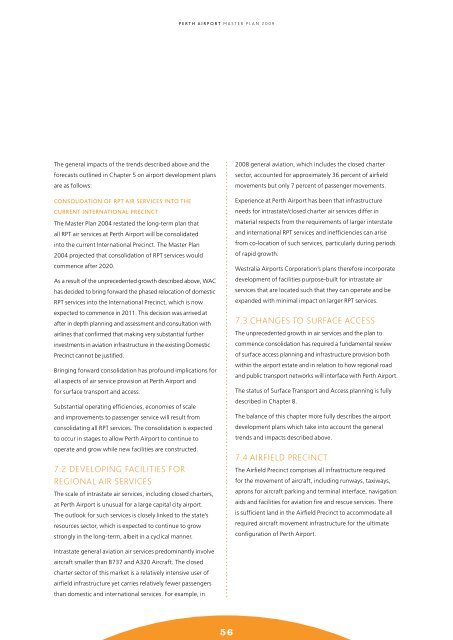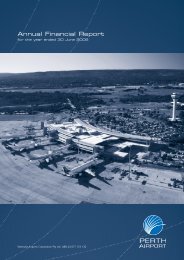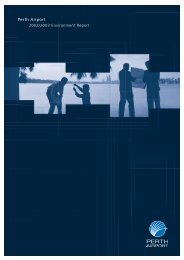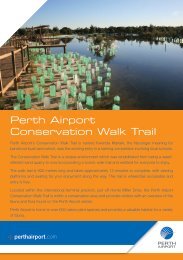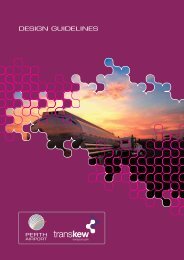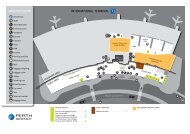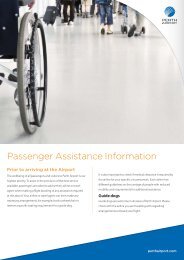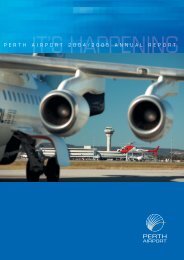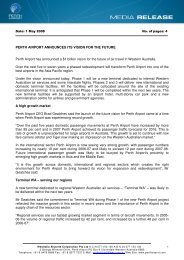PERTH AIRPORT Master Plan 2009
PERTH AIRPORT Master Plan 2009
PERTH AIRPORT Master Plan 2009
Create successful ePaper yourself
Turn your PDF publications into a flip-book with our unique Google optimized e-Paper software.
P E R T H A I R P O R T M a s t e r P l a n 2 0 0 9<br />
The general impacts of the trends described above and the<br />
forecasts outlined in Chapter 5 on airport development plans<br />
are as follows:<br />
Consolidation of RPT Air Services into the<br />
Current International Precinct<br />
The <strong>Master</strong> <strong>Plan</strong> 2004 restated the long-term plan that<br />
all RPT air services at Perth Airport will be consolidated<br />
into the current International Precinct. The <strong>Master</strong> <strong>Plan</strong><br />
2004 projected that consolidation of RPT services would<br />
commence after 2020.<br />
As a result of the unprecedented growth described above, WAC<br />
has decided to bring forward the phased relocation of domestic<br />
RPT services into the International Precinct, which is now<br />
expected to commence in 2011. This decision was arrived at<br />
after in depth planning and assessment and consultation with<br />
airlines that confirmed that making very substantial further<br />
investments in aviation infrastructure in the existing Domestic<br />
Precinct cannot be justified.<br />
Bringing forward consolidation has profound implications for<br />
all aspects of air service provision at Perth Airport and<br />
for surface transport and access.<br />
Substantial operating efficiencies, economies of scale<br />
and improvements to passenger service will result from<br />
consolidating all RPT services. The consolidation is expected<br />
to occur in stages to allow Perth Airport to continue to<br />
operate and grow while new facilities are constructed.<br />
7.2 Developing Facilities for<br />
Regional Air Services<br />
The scale of intrastate air services, including closed charters,<br />
at Perth Airport is unusual for a large capital city airport.<br />
The outlook for such services is closely linked to the state’s<br />
resources sector, which is expected to continue to grow<br />
strongly in the long-term, albeit in a cyclical manner.<br />
2008 general aviation, which includes the closed charter<br />
sector, accounted for approximately 36 percent of airfield<br />
movements but only 7 percent of passenger movements.<br />
Experience at Perth Airport has been that infrastructure<br />
needs for intrastate/closed charter air services differ in<br />
material respects from the requirements of larger interstate<br />
and international RPT services and inefficiencies can arise<br />
from co-location of such services, particularly during periods<br />
of rapid growth.<br />
Westralia Airports Corporation’s plans therefore incorporate<br />
development of facilities purpose-built for intrastate air<br />
services that are located such that they can operate and be<br />
expanded with minimal impact on larger RPT services.<br />
7.3 Changes to Surface Access<br />
The unprecedented growth in air services and the plan to<br />
commence consolidation has required a fundamental review<br />
of surface access planning and infrastructure provision both<br />
within the airport estate and in relation to how regional road<br />
and public transport networks will interface with Perth Airport.<br />
The status of Surface Transport and Access planning is fully<br />
described in Chapter 8.<br />
The balance of this chapter more fully describes the airport<br />
development plans which take into account the general<br />
trends and impacts described above.<br />
7.4 Airfield Precinct<br />
The Airfield Precinct comprises all infrastructure required<br />
for the movement of aircraft, including runways, taxiways,<br />
aprons for aircraft parking and terminal interface, navigation<br />
aids and facilities for aviation fire and rescue services. There<br />
is sufficient land in the Airfield Precinct to accommodate all<br />
required aircraft movement infrastructure for the ultimate<br />
configuration of Perth Airport.<br />
Intrastate general aviation air services predominantly involve<br />
aircraft smaller than B737 and A320 Aircraft. The closed<br />
charter sector of this market is a relatively intensive user of<br />
airfield infrastructure yet carries relatively fewer passengers<br />
than domestic and international services. For example, in<br />
56


